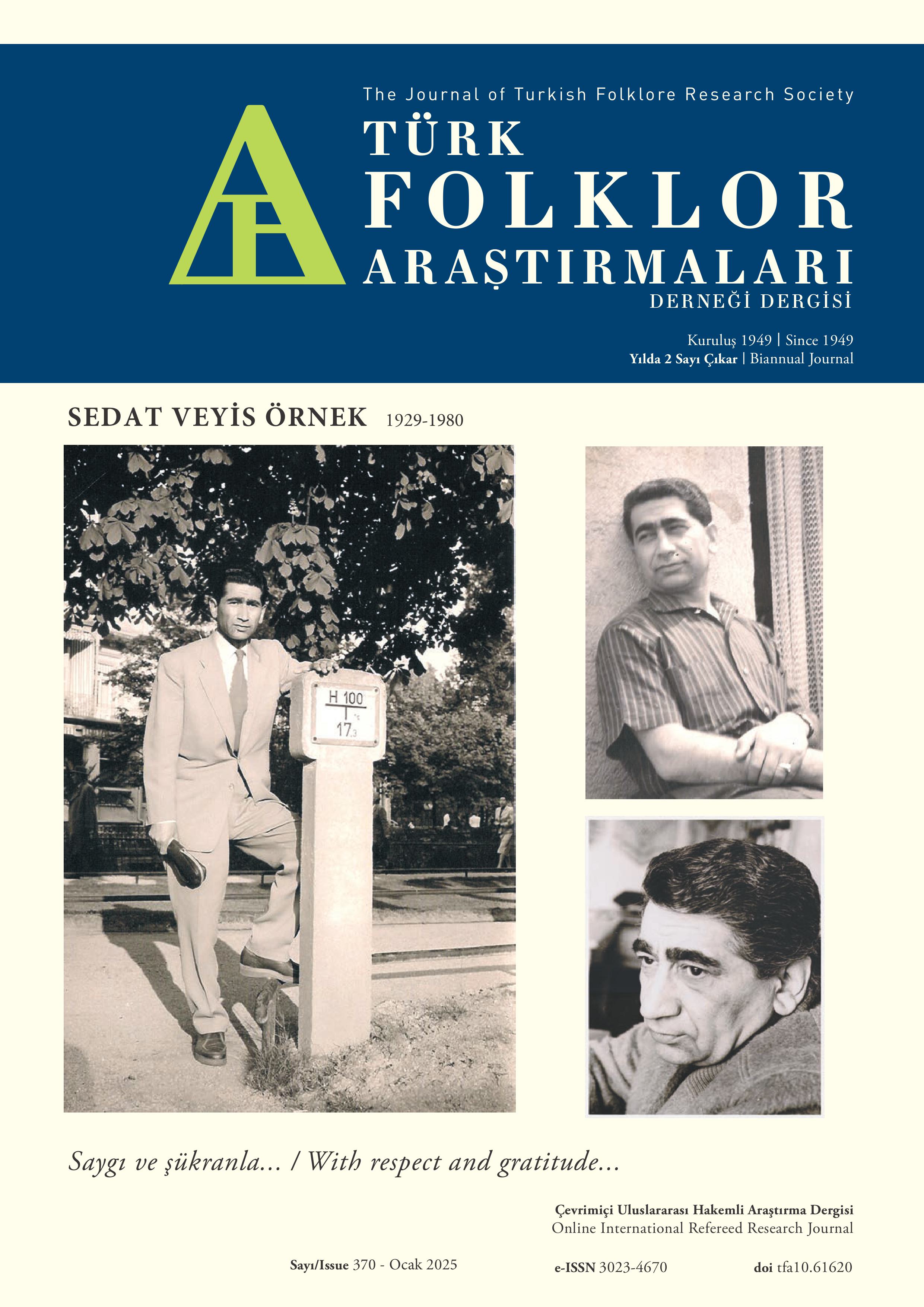UNESCO Acil Koruma Gerektiren Soküm Listesi’ne Karşılaştırmalı Bakış: Moğolistan, Uganda, Çin ve Türkiye Örnekleri
DOI:
https://doi.org/10.61620/tfa.45Anahtar Kelimeler:
Moğolistan, cil koruma gerektiren SOKÜM listesi, Uganda, Çin, Türkiye, yerel yönetimlerÖzet
UNESCO tarafından 2003 yılında kabul edilen “Somut Olmayan Kültürel Mirasın Korunması Sözleşmesi (SOKÜM)”, Aralık 2024 tarihi itibariyle, 183 Taraf Devlet tarafından imzalandığı günden bu yana uluslararası alanda en çok ilgi çeken kültür sözleşmelerinden biri olmuştur. Sözleşme bağlamında oluşturulmuş “SOKÜM Listeleri”, Taraf Devletlerin kültürel miras unsurlarının korumaya yönelik çalışmalarının uluslararası alanda görünen yüzü olmuştur. En çok ilgi gören “İnsanlığın SOKÜM Temsilî Listesi (TL)” olmak üzere; giderek önemi ve gerekliliği konusu sıkça vurgulanan “Acil Koruma Gerektiren SOKÜM Listesi (AKL)” ve “Korumanın İyi Uygulamalar Kaydı (İUK)” söz konusu listelerdir. Sözleşme’nin bir kültürel miras unsurunu en hızlı şekliyle koruma ve yaşatma mantığına en uygun liste, AKL’dir. Sözleşmenin karar verici organı olan Komite’nin son yıllarda TL’de oluşan yoğunluktan dolayı söz konusu Taraf Devlet/ler’in listelerde kayıtlı olan unsur sayılarını da göz önünde bulundurarak, önceliği AKL’ye ve İUK’a verdiği bilinmektedir. Herhangi bir unsurun AKL’ye kayıt ettirilebilmesi için Komite tarafından yapılan değerlendirmelerde, unsurun sürdürülebilirliğine ve uygulanabilirliğine dikkat edilmektedir. Ayrıca, bu mirası korumaya yönelik araçların bulunup bulunmadığı; geleneksel bilgi taşıyıcılarının, yerel yönetimlerin, belediyelerin ve STK’ların katkıları; aktarımın ne derece gerçekleştirilebildiği ya da küreselleşme nedeniyle kaybolma riskinin ne boyutta olduğu gibi kriterlerin değerlendirilme sürecinde önemli olduğu görülmektedir. Türkiye’nin AKL’de, Aralık 2024 itibariyle, “Islık Dili”, “Geleneksel Ahlat Taş İşçiliğ”i ve “Zeytin Yetiştiriciliği ile İlgili Geleneksel Bilgi, Yöntem ve Uygulamalar” başlıklı üç unsuru bulunmaktadır. AKL’ye kayıtlı unsur sayısı en fazla olan üç ülke, Moğolistan, Uganda ve Çin’dir. Komite’nin korumaya yönelik yaklaşımları ve uygulama süreçlerinde değerlendirme kriterleri dikkate alındığında AKL’deki unsurların önemi ve değeri kadar, sayıca da artacağı öngörülebilir. Bu makalede, Türkiye’nin AKL’de yer alan üç unsuruna ek olarak, listeye kayıtlı unsur sayısı en fazla olan ilk üç ülkeden farklı SOKÜM alanlarına dâhil birer örnek seçilerek bu unsurların koruma süreçlerinde yerel yönetimlerin önemi ve katkıları aktarılmaya çalışılmıştır.
Referanslar
Empaako tradition of the Batooro, Banyoro, Batuku, Batagwenda and Banyabindi of western Uganda Nomination Form (2013), Nomination File No: 00904, List of Intangiable Cultural Heritage in Need of Urgent Safeguarding, https://ich.unesco.org/en/USL/empaako-tradition-of-the-batooro-banyoro-batuku-batagwenda-and-banyabindi-of-western-uganda-00904, Erişim tarihi 08.12.2024.
Empaako tradition of the Batooro, Banyoro, Batuku, Batagwenda and Banyabindi of western Uganda, Consent Communities (2013). File No: 16995, https://ich.unesco.org/doc/src/16995-EN.pdf, Erişim tarihi 08.12.2024.
Gürçayır, S. (2011). “Somut Olmayan Kültürel Mirasın Korunması Sözleşmesi Üzerine Eleştirel Bir Okuma”, Millî Folklor, Yıl 23, Sayı 92, s. 5-12.
Gürçayır Teke, S. (2013). "Sivil Toplum Kuruluşları ve Somut Olmayan Kültürel Miras: Katılım, Akreditasyon ve Eksiklikler", Somut Olmayan Kültürel Mirasın Geleceği Türkiye Deneyimi, (Ed. M. Öcal Oğuz vd.), s.43-47, Ankara: UNESCO Türkiye Millî Komisyonu Yayını.
Karakul, Ö., Yıldız, T. (2020). The Role of Local Governments in the Conservation of Cultural Heritage-Türkiye [Kültürel Mirasın Korunmasında Yerel Yönetimlerin Rolü-Türkiye], UCLG-MEWA, İstanbul). https://uclg-mewa.org/uploads/file/6d44af25b1604d4894507cf8658500ef/Kulturel_Mirasin_Korunmasinda_Yerel_Yonetimlerin_Rolu-Turkiye.pdf, Erişim tarihi 24.10.2024.
Karakul, Ö. (2023). “Kültürel Mirasın Bütüncül Korunmasında Yerel Yönetimlerin Rolü: Somut ve Somut Olmayan Miras Koruma Deneyimleri”, Kültür Mirası Yönetı̇mı̇: Neden ve Nasıl? Türkiye'den Deneyimler ve Tartışmalar, s. 717- 735, İstanbul: İstanbul Bilgi Üniversitesi Yayınları.
Metin Basat, E. (2013). “Somut Olmayan Kültürel Miras ve Yerel Yönetim Uygulamaları”, Somut Olmayan Kültürel Mirasın Geleceği Türkiye Deneyimi, (Ed. M. Öcal Oğuz vd.), Ankara: UNESCO Türkiye Millî Komisyonu Yayını.
Mongol Biyelgee, Mongolian traditional folk dance Nomination Form (2009), Nomination File No: 00311, List of Intangiable Cultural Heritage in Need of Urgent Safeguarding, https://ich.unesco.org/en/USL/mongol-biyelgee-mongolian-traditional-folk-dance-00311, Erişim tarihi 08.12.2024.
Mongol Biyelgee, Mongolian traditional folk dance Consent Communities (2009). File No: 01221, https://ich.unesco.org/doc/src/01221.pdf, Erişim tarihi 08.12.2024.
Oğuz, Ö. (2017). “Onuncu Yılında Somut Olmayan Kültürel Miras Listeleri: Görünürlük, Değerlilik ve Güvenirlik”, Millî Folklor, Yıl 29, Sayı 116, s. 5-17.
Somut Olmayan Kültürel Mirasın Korunması Sözleşmesi, (2005). Millî Folklor, (Fr. Çev.: M. Öcal Oğuz, İng. Çev.: Yeliz Özay, Göz. Geç.: Pulat Tacar), Yıl: 17, Sayı: 65, s.: 163-171.
Traditional Ahlat Stonework Nomination Form (2022), Nomination File No: 00655, List of Intangiable Cultural Heritage in Need of Urgent Safeguarding, https://ich.unesco.org/en/USL/traditional-ahlat-stonework-00655, Erişim tarihi 08.12.2024.
Traditional Ahlat Stonework Inventery (2022), File No: 51984, https://ich.unesco.org/doc/src/33899.pdf, Erişim tarihi 08.12.2024.
Traditional Ahlat Stonework Consent Communities (2022). File No: 51985, https://ich.unesco.org/doc/src/34811.pdf, Erişim tarihi 08.12.2024.
UNESCO Intergovermental Committee For The Safeguarding of the Intangible Cultural Heritage Decisions Report (2007), ITH/07/1.EXT.COM/CONF.207/Decisions, Chengdu, 26 May 2007, https://unesdoc.unesco.org/ark:/48223/pf0000234392, Erişim tarihi 08.12.2024.
UNESCO Listelerinde Türkiye: https://ich.unesco.org/en/lists?text=&country[]=00228&multinational=3#tabs, Erişim tarihi 08.12.2024.
Uygulama Yönergesi (Operational Directives for the Implementation of the Convention for the Safeguarding of the Intangible Cultural Heritage) (2022). https://ich.unesco.org/doc/src/2003_Convention_Basic_Texts-_2022_version-EN_.pdf, Erişim tarihi 08.12.2024.
Whistled Language Nomination Form (2017), Nomination File No: 00658 for Inscription in 2017 on the List of Intangiable Cultural Heritage in Need of Urgent Safeguarding, https://ich.unesco.org/en/USL/whistled-language-00658, Erişim tarihi 08.12.2024.
Whistled Language Inventery (2016), File No: 33899, https://ich.unesco.org/doc/src/33899.pdf, Erişim tarihi 08.12.2024.
Whistled Language Consent Communities (2016). File No: 34811, https://ich.unesco.org/doc/src/34811.pdf, Erişim tarihi 08.12.2024.
Wooden movable-type printing of China (2010), Nomination File No: 00322, List of Intangiable Cultural Heritage in Need of Urgent Safeguarding, https://ich.unesco.org/en/USL/wooden-movable-type-printing-of-china-00322, Erişim tarihi 08.12.2024.
Wooden movable-type printing of China (2022), Report on the Status of an Element Inscribed on the List of Intangible Cultural Heritage In Need of Urgent Safeguarding, https://ich.unesco.org/en/state/china-CN?info=periodic-reporting#usl-0326-2019, Erişim tarihi 08.12.2024.
Yıldız, T. (2020). Somut Olmayan Kültürel Miras Yönetimi: Sivil Toplum Katılımı, Ankara: Geleneksel Yayıncılık.
Traditional knowledge, methods and practices concerning olive cultivation (2023), https://ich.unesco.org/en/USL/traditional-knowledge-methods-and-practices-concerning-olive-cultivation-01983, Erişim tarihi 08.12.2024.
İndir
Yayınlanmış
Nasıl Atıf Yapılır
Sayı
Bölüm
Lisans
Telif Hakkı (c) 2025 Pınar Kasapoğlu

Bu çalışma Creative Commons Attribution 4.0 International License ile lisanslanmıştır.



